Hyundai Tiburon 2004 Owner's Manual
Manufacturer: HYUNDAI, Model Year: 2004, Model line: Tiburon, Model: Hyundai Tiburon 2004Pages: 224, PDF Size: 18.86 MB
Page 201 of 224
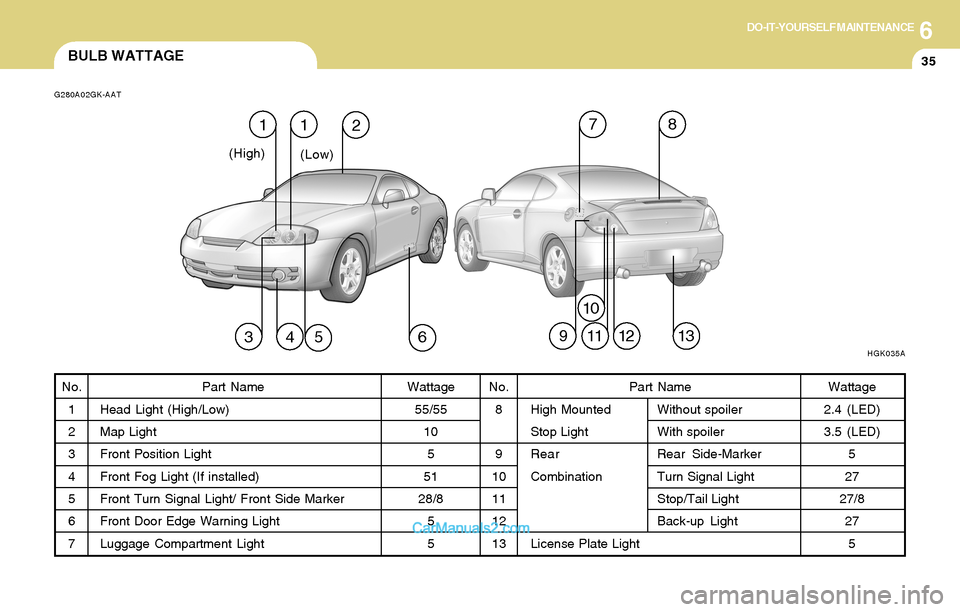
6DO-IT-YOURSELF MAINTENANCE
35BULB WATTAGE
G280A02GK-AAT
No.
1
2
3
4
5
6
7Part Name
Head Light (High/Low)
Map Light
Front Position Light
Front Fog Light (If installed)
Front Turn Signal Light/ Front Side Marker
Front Door Edge Warning Light
Luggage Compartment LightWattage
55/55
10
5
51
28/8
5
5No.
8
9
10
11
12
13Wattage
2.4 (LED)
3.5 (LED)
5
27
27/8
27
5 Part Name
High Mounted Without spoiler
Stop Light With spoiler
RearRear Side-Marker
Combination Turn Signal Light
Stop/Tail Light
Back-up Light
License Plate Light
42HGK035A6
(High)
(Low)
31112139
1178
5
10
Page 202 of 224
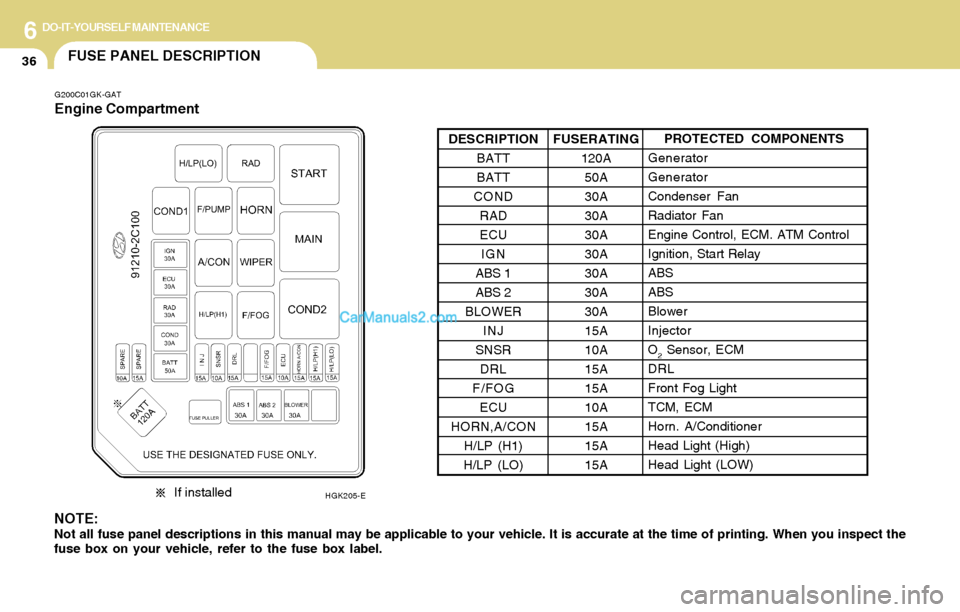
6DO-IT-YOURSELF MAINTENANCE
36FUSE PANEL DESCRIPTION
G200C01GK-GAT
Engine Compartment
If installed
NOTE:Not all fuse panel descriptions in this manual may be applicable to your vehicle. It is accurate at the time of printing. When you inspect the
fuse box on your vehicle, refer to the fuse box label.
HGK205-E
PROTECTED COMPONENTS
Generator
Generator
Condenser Fan
Radiator Fan
Engine Control, ECM. ATM Control
Ignition, Start Relay
ABS
ABS
Blower
Injector
O
2 Sensor, ECM
DRL
Front Fog Light
TCM, ECM
Horn. A/Conditioner
Head Light (High)
Head Light (LOW) FUSERATING
120A
50A
30A
30A
30A
30A
30A
30A
30A
15A
10A
15A
15A
10A
15A
15A
15A DESCRIPTION
BATT
BATT
COND
RAD
ECU
IGN
ABS 1
ABS 2
BLOWER
INJ
SNSR
DRL
F/FOG
ECU
HORN,A/CON
H/LP (H1)
H/LP (LO)
Page 203 of 224
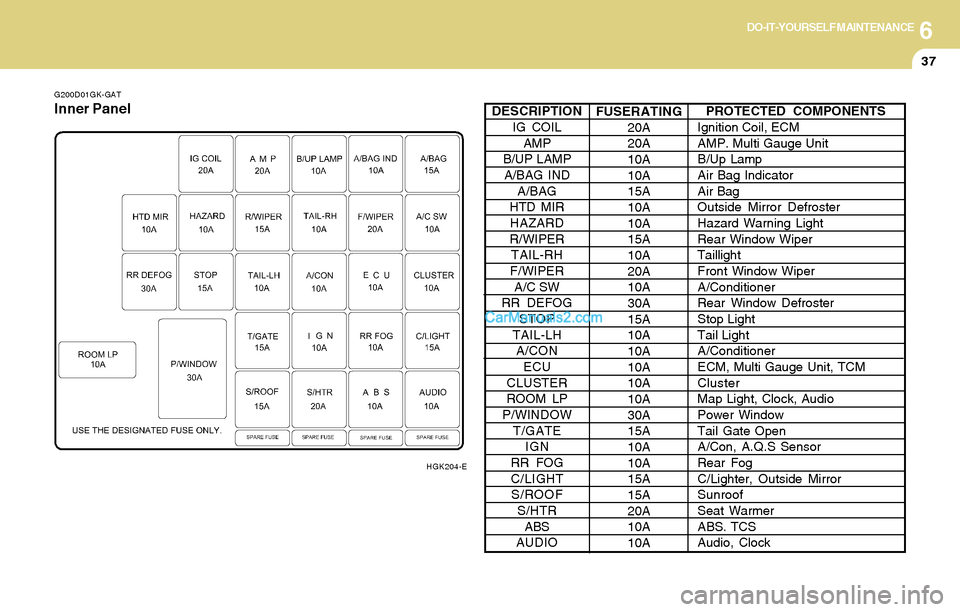
6DO-IT-YOURSELF MAINTENANCE
37
G200D01GK-GAT
Inner Panel
HGK204-E
DESCRIPTION
IG COIL
AMP
B/UP LAMP
A/BAG IND
A/BAG
HTD MIR
HAZARD
R/WIPER
TAIL-RH
F/WIPER
A/C SW
RR DEFOG
STOP
TAIL-LH
A/CON
ECU
CLUSTER
ROOM LP
P/WINDOW
T/GATE
IGN
RR FOG
C/LIGHT
S/ROOF
S/HTR
ABS
AUDIOPROTECTED COMPONENTS
Ignition Coil, ECM
AMP. Multi Gauge Unit
B/Up Lamp
Air Bag Indicator
Air Bag
Outside Mirror Defroster
Hazard Warning Light
Rear Window Wiper
Taillight
Front Window Wiper
A/Conditioner
Rear Window Defroster
Stop Light
Tail Light
A/Conditioner
ECM, Multi Gauge Unit, TCM
Cluster
Map Light, Clock, Audio
Power Window
Tail Gate Open
A/Con, A.Q.S Sensor
Rear Fog
C/Lighter, Outside Mirror
Sunroof
Seat Warmer
ABS. TCS
Audio, Clock FUSERATING
20A
20A
10A
10A
15A
10A
10A
15A
10A
20A
10A
30A
15A
10A
10A
10A
10A
10A
30A
15A
10A
10A
15A
15A
20A
10A
10A
Page 204 of 224
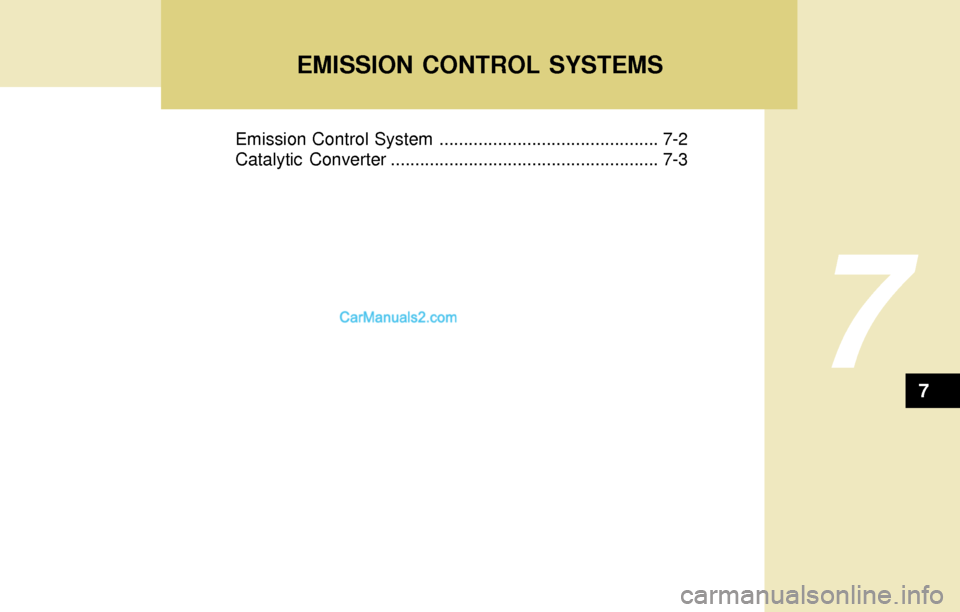
EMISSION CONTROL SYSTEMS
7
Emission Control System ............................................. 7-2
Catalytic Converter ....................................................... 7-3
7
Page 205 of 224
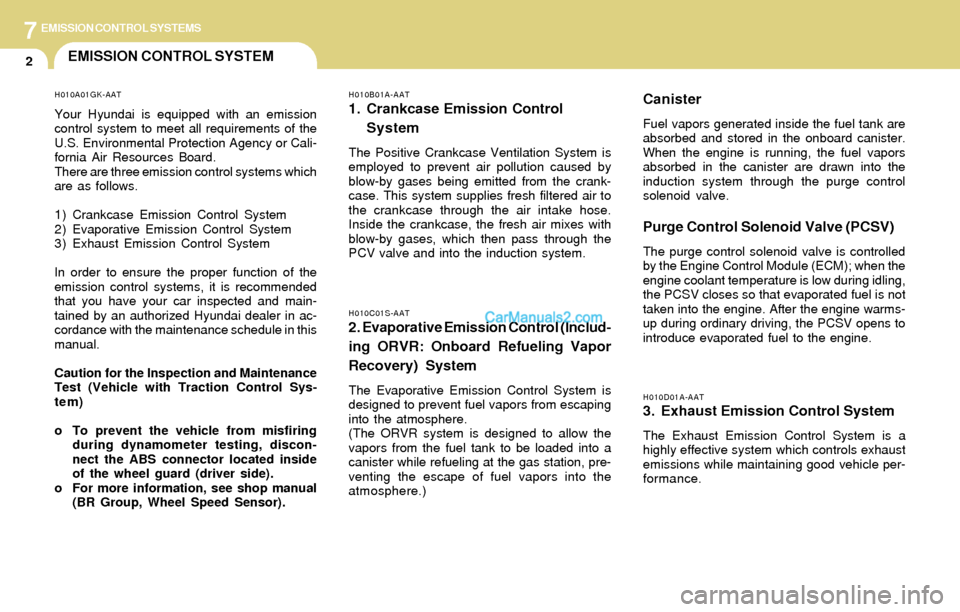
7EMISSION CONTROL SYSTEMS
2EMISSION CONTROL SYSTEM
H010D01A-AAT3. Exhaust Emission Control System
The Exhaust Emission Control System is a
highly effective system which controls exhaust
emissions while maintaining good vehicle per-
formance.
H010B01A-AAT
1. Crankcase Emission Control
System
The Positive Crankcase Ventilation System is
employed to prevent air pollution caused by
blow-by gases being emitted from the crank-
case. This system supplies fresh filtered air to
the crankcase through the air intake hose.
Inside the crankcase, the fresh air mixes with
blow-by gases, which then pass through the
PCV valve and into the induction system.
H010A01GK-AAT
Your Hyundai is equipped with an emission
control system to meet all requirements of the
U.S. Environmental Protection Agency or Cali-
fornia Air Resources Board.
There are three emission control systems which
are as follows.
1) Crankcase Emission Control System
2) Evaporative Emission Control System
3) Exhaust Emission Control System
In order to ensure the proper function of the
emission control systems, it is recommended
that you have your car inspected and main-
tained by an authorized Hyundai dealer in ac-
cordance with the maintenance schedule in this
manual.
Caution for the Inspection and Maintenance
Test (Vehicle with Traction Control Sys-
tem)
o To prevent the vehicle from misfiring
during dynamometer testing, discon-
nect the ABS connector located inside
of the wheel guard (driver side).
o For more information, see shop manual
(BR Group, Wheel Speed Sensor).Canister
Fuel vapors generated inside the fuel tank are
absorbed and stored in the onboard canister.
When the engine is running, the fuel vapors
absorbed in the canister are drawn into the
induction system through the purge control
solenoid valve.
Purge Control Solenoid Valve (PCSV)
The purge control solenoid valve is controlled
by the Engine Control Module (ECM); when the
engine coolant temperature is low during idling,
the PCSV closes so that evaporated fuel is not
taken into the engine. After the engine warms-
up during ordinary driving, the PCSV opens to
introduce evaporated fuel to the engine.
H010C01S-AAT
2. Evaporative Emission Control (Includ-
ing ORVR: Onboard Refueling Vapor
Recovery) System
The Evaporative Emission Control System is
designed to prevent fuel vapors from escaping
into the atmosphere.
(The ORVR system is designed to allow the
vapors from the fuel tank to be loaded into a
canister while refueling at the gas station, pre-
venting the escape of fuel vapors into the
atmosphere.)
Page 206 of 224
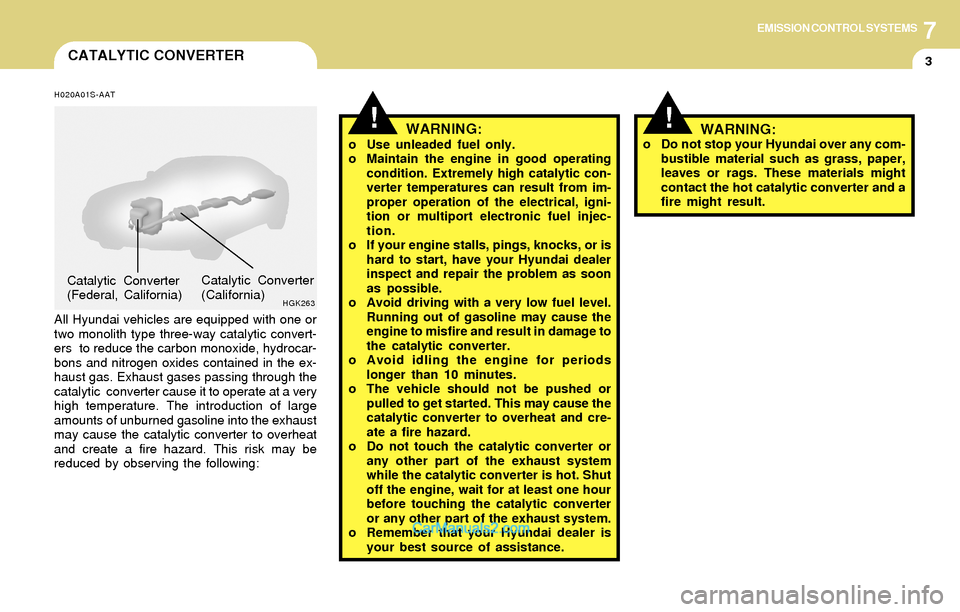
7EMISSION CONTROL SYSTEMS
3CATALYTIC CONVERTER
!WARNING:o Use unleaded fuel only.
o Maintain the engine in good operating
condition. Extremely high catalytic con-
verter temperatures can result from im-
proper operation of the electrical, igni-
tion or multiport electronic fuel injec-
tion.
o If your engine stalls, pings, knocks, or is
hard to start, have your Hyundai dealer
inspect and repair the problem as soon
as possible.
o Avoid driving with a very low fuel level.
Running out of gasoline may cause the
engine to misfire and result in damage to
the catalytic converter.
o Avoid idling the engine for periods
longer than 10 minutes.
o The vehicle should not be pushed or
pulled to get started. This may cause the
catalytic converter to overheat and cre-
ate a fire hazard.
o Do not touch the catalytic converter or
any other part of the exhaust system
while the catalytic converter is hot. Shut
off the engine, wait for at least one hour
before touching the catalytic converter
or any other part of the exhaust system.
o Remember that your Hyundai dealer is
your best source of assistance.
H020A01S-AAT
All Hyundai vehicles are equipped with one or
two monolith type three-way catalytic convert-
ers to reduce the carbon monoxide, hydrocar-
bons and nitrogen oxides contained in the ex-
haust gas. Exhaust gases passing through the
catalytic converter cause it to operate at a very
high temperature. The introduction of large
amounts of unburned gasoline into the exhaust
may cause the catalytic converter to overheat
and create a fire hazard. This risk may be
reduced by observing the following:
HGK263
Catalytic Converter
(California) Catalytic Converter
(Federal, California)
o Do not stop your Hyundai over any com-
bustible material such as grass, paper,
leaves or rags. These materials might
contact the hot catalytic converter and a
fire might result.WARNING:!
Page 207 of 224
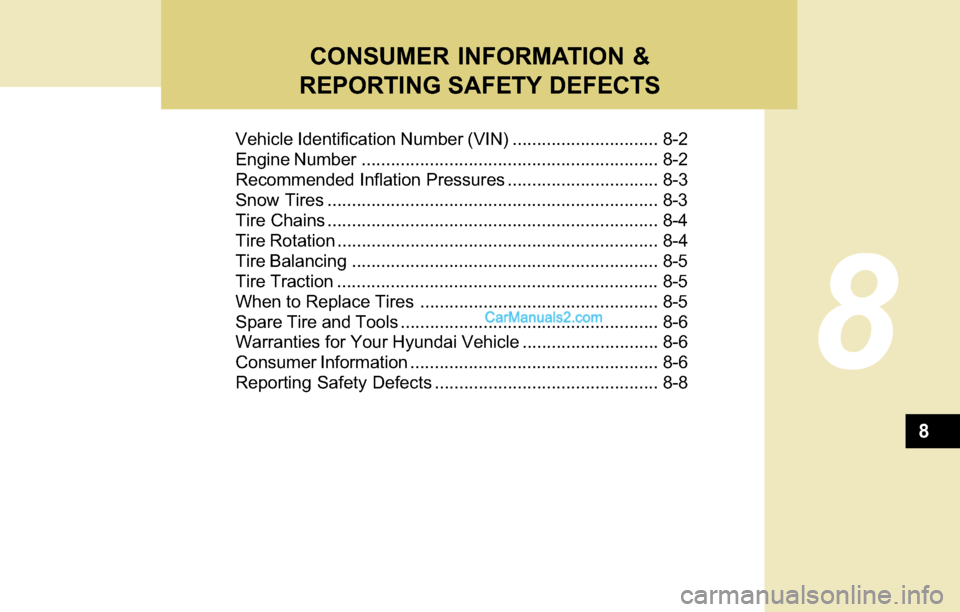
Vehicle Identification Number (VIN) .............................. 8-2
Engine Number............................................................. 8-2
Recommended Inflation Pressures............................... 8-3
Snow Tires.................................................................... 8-3
Tire Chains.................................................................... 8-4
Tire Rotation .................................................................. 8-4
Tire Balancing............................................................... 8-5
Tire Traction.................................................................. 8-5
When to Replace Tires ................................................. 8-5
Spare Tire and Tools ..................................................... 8-6
Warranties for Your Hyundai Vehicle ............................ 8-6
Consumer Information................................................... 8-6
Reporting Safety Defects .............................................. 8-8
CONSUMER INFORMATION &
REPORTING SAFETY DEFECTS
8
8
Page 208 of 224
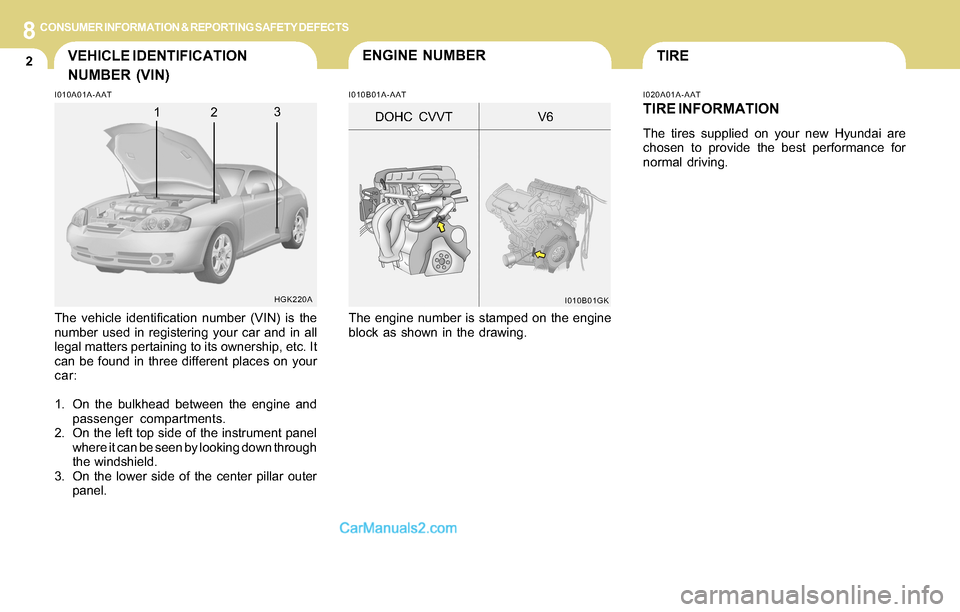
8CONSUMER INFORMATION & REPORTING SAFETY DEFECTS
2TIREENGINE NUMBERVEHICLE IDENTIFICATION
NUMBER (VIN)
I020A01A-AAT
TIRE INFORMATION
The tires supplied on your new Hyundai are
chosen to provide the best performance for
normal driving.
I010B01A-AAT I010A01A-AAT
The vehicle identification number (VIN) is the
number used in registering your car and in all
legal matters pertaining to its ownership, etc. It
can be found in three different places on your
car:
1. On the bulkhead between the engine and
passenger compartments.
2. On the left top side of the instrument panel
where it can be seen by looking down through
the windshield.
3. On the lower side of the center pillar outer
panel.The engine number is stamped on the engine
block as shown in the drawing.
HGK220A
I010B01GK
DOHC CVVT V6231
Page 209 of 224

8CONSUMER INFORMATION & REPORTING SAFETY DEFECTS
3
!
I040A01S-AAT
SNOW TIRES
If you equip your car with snow tires, they should
be the same size and have the same load
capacity as the original tires. Snow tires should
be installed on all four wheels; otherwise, poor
handling may result.
Snow tires should carry 4 psi (28 kPa) more air
pressure than the pressure recommended for
the standard tires on the tire label on the driver
side center piller outer panel or up to the maxi-
mum pressure shown on the tire sidewall which-
ever is less.
Do not drive faster than 75 mph (120 km/h)
when your car is equipped with snow tires.
I030A02GK-AAT
RECOMMENDED INFLATION PRES-
SURES
The tire label located on the driver side center
pillar outer panel gives the tire pressures rec-
ommended for your vehicle.These pressures were chosen to provide the
most satisfactory combination of ride comfort,
tire wear and stability under normal conditions.
Tire pressures should be checked at least
monthly. Proper tire inflation pressures should
be maintained for these reasons:
o Lower-than-recommended tire pressures
cause uneven tread wear and poor handling.
o Higher-than-recommended tire pressures
increase the chance of damage from im-
pacts and cause uneven tread wear.
CAUTION:Always observe the following:
o Check pressures when the tires are cold.
That is, after the car has been parked for
at least three hours and hasn't been
driven more than one mile or 1.6 km since
starting up.
o Check the pressure of your spare tire
each time you check the pressure of
other tires.HGK092
TIRE
SIZE RIM
SIZEPRESSURE, kPa (PSI)
REAR
210(30)
210(30)
210(30)
420(60)FRONT
210(30)
230(33)
240(35)
420(60) UP TO 2
PERSONSUP TO
MAX. LOAD
REAR
210(30)
230(33)
230(33)
420(60) FRONT
210(30)
210(30)
220(32)
420(60)
6.0Jx15
6.5Jx16
7.0Jx17
4Tx16195/65R15
205/55R16
215/45R17
T125/70R16
Page 210 of 224
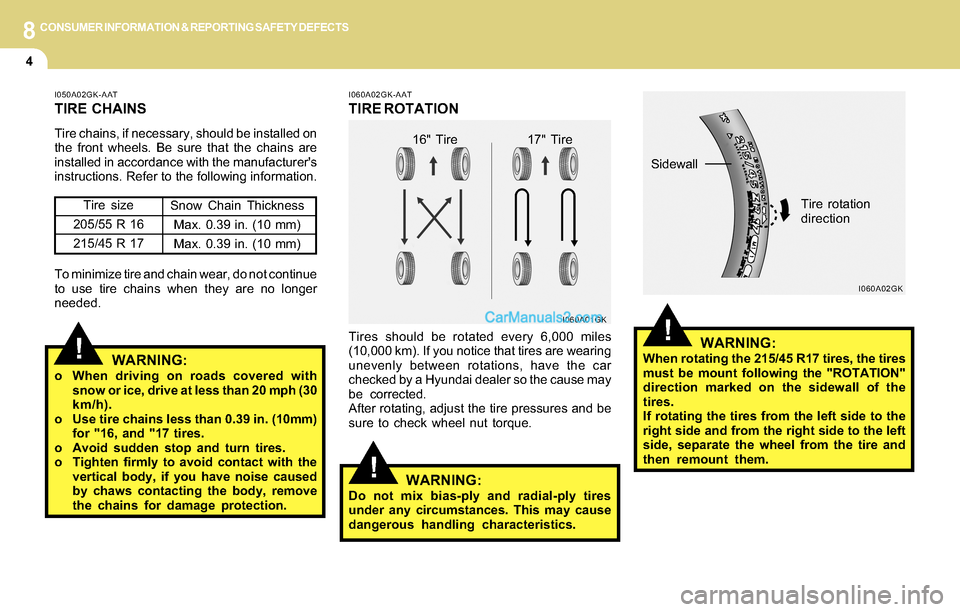
8CONSUMER INFORMATION & REPORTING SAFETY DEFECTS
4
!
I060A02GK-AAT
TIRE ROTATION
Tires should be rotated every 6,000 miles
(10,000 km). If you notice that tires are wearing
unevenly between rotations, have the car
checked by a Hyundai dealer so the cause may
be corrected.
After rotating, adjust the tire pressures and be
sure to check wheel nut torque.
WARNING:Do not mix bias-ply and radial-ply tires
under any circumstances. This may cause
dangerous handling characteristics.
I060A01GK
!
I050A02GK-AAT
TIRE CHAINS
Tire chains, if necessary, should be installed on
the front wheels. Be sure that the chains are
installed in accordance with the manufacturer's
instructions. Refer to the following information.
WARNING:o When driving on roads covered with
snow or ice, drive at less than 20 mph (30
km/h).
o Use tire chains less than 0.39 in. (10mm)
for "16, and "17 tires.
o Avoid sudden stop and turn tires.
o Tighten firmly to avoid contact with the
vertical body, if you have noise caused
by chaws contacting the body, remove
the chains for damage protection. To minimize tire and chain wear, do not continue
to use tire chains when they are no longer
needed.Tire size
205/55 R 16
215/45 R 17
Snow Chain Thickness
Max. 0.39 in. (10 mm)
Max. 0.39 in. (10 mm)
16" Tire 17" Tire
!WARNING:When rotating the 215/45 R17 tires, the tires
must be mount following the "ROTATION"
direction marked on the sidewall of the
tires.
If rotating the tires from the left side to the
right side and from the right side to the left
side, separate the wheel from the tire and
then remount them.
I060A02GK
Sidewall
Tire rotation
direction